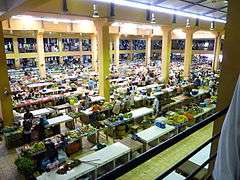Economy of São Tomé and Príncipe
 A market place located in the capital city of São Tomé | |
| Currency | São Tomé and Príncipe Dobra (STD) |
|---|---|
| Calendar Year | |
| Statistics | |
| GDP |
Rank: 217 (2012 est.) |
GDP growth |
|
GDP per capita |
$2,400 (PPP) (2012 est.) Rank: 186 (2012 est.)[1] |
GDP by sector |
agriculture (13.9%) industry (19.5%) services (66.5%) (2012 est.) |
|
| |
Population below poverty line | 66.2% (2009 est.) |
Labour force | 52,490 (2007 est.) |
Labour force by occupation | Population mainly engaged in subsistence agriculture and fishing (note: shortages of skilled workers) |
Main industries | light construction, textiles, soap, beer, fish processing, timber |
| 163rd[2] | |
| External | |
| Exports |
|
Export goods | cocoa, copra, coffee, palm oil |
Main export partners |
|
| Imports |
|
Import goods | machinery, electrical equipment, petroleum products, food |
Main import partners |
|
Gross external debt |
|
| Public finances | |
|
| |
|
| |
| Revenues | $105.5 million (2012 est.) |
| Expenses | $131.8 million (2012 est.) |
Foreign reserves |
|
The economy of São Tomé and Príncipe, while traditionally dependent on cocoa, is experiencing considerable changes due to investment in the development of its oil industry in the oil-rich waters of the Gulf of Guinea. In 2003, the government agreed a Joint Development Zone over the area which gives Sao Tome 40% of revenues.
History
Under Portuguese colonial rule, sugar plantations were set up, and the islands were used for the transshipment of slaves.[5]
Oil reserves
Geologists estimate that the Gulf of Guinea zone (Niger Delta province) holds more than 10 billion barrels (1.6 km³) of oil, although no reserves have yet been proved. A joint oil project with Nigeria in 2005 is likely to contribute $50 million of revenues to the government from the exploration licence signing fees. This represents four times government revenues in 2004. São Tomé is optimistic that significant petroleum discoveries under the exploration licence are forthcoming.
In 2006, the first tests in the deep-water block struck oil, but not in commercially viable quantities.[6]
Agriculture
Since the 1800s, the economy of São Tomé and Príncipe has been based on plantation agriculture. At the time of independence, Portuguese-owned plantations occupied 90% of the cultivated area. After independence, control of these plantations passed to various state-owned agricultural enterprises. The dominant crop on São Tomé is cocoa, representing about 95% of exports. Other export crops include copra, palm kernels, and coffee.
Economic issues
The government has an economic program that is supported by the IMF, via its Extended Credit Facility arrangement.[7]
Data
Gross domestic product: purchasing power parity - $316.9 million (2010 est.), $214 million (2003 est.)
GDP - real growth rate: 6% (2010 est.), 5% (2004 est.)
GDP - per capita: purchasing power parity - $1,800 (2010 est.), $1,200 (2003 est.)
GDP - composition by sector: (2010 est.)
- agriculture: 14.7%
- industry: 22.9%
- services: 62%
Inflation rate (consumer prices): 13% (2010 est.)
Labor force - by occupation:
population mainly engaged in subsistence agriculture and fishing
note:
shortages of skilled workers
Unemployment rate: 50% in the formal business sector (1998 est.)
Budget:
- revenues: $58 million
- expenditures: $114 million, including capital expenditures of $54 million (1993 est.)
Industries: light construction, textiles, soap, beer; fish processing; timber
Electricity - production: 15 million kWh (1998)
Electricity - production by source:
- fossil fuel: 46.67%
- hydro: 53.33%
- nuclear: 0%
- other: 0% (1998)
Electricity - consumption: 14 GWh (1998)
Electricity - exports: 0 kWh (1998)
Electricity - imports: 0 kWh (1998)
Agriculture - products: cocoa, coconuts, palm kernels, copra, cinnamon, pepper, coffee, bananas, papayas, beans; poultry; fish
Exports: $13 million (2010 est.)
Exports - commodities: cocoa 80%, copra, coffee, palm oil (2009)
Exports - partners: United Kingdom 32.99%, Netherlands 26.93%, Belgium 21.04%, Portugal 4.31% (2009)
Imports: $99 million (2010 est.)
Petroleum - it needs to import all of its required petroleum[8]
See also
References
- ↑ "Sao Tome and Principe Country Profile: Human Development Indicators". Human Development Reports. UN. Retrieved 5 February 2013.
- ↑ "Doing Business in São Tomé and Príncipe 2012". World Bank. Retrieved 2011-11-18.
- ↑ "Export Partners of São Tomé and Príncipe". CIA World Factbook. 2012. Retrieved 2013-07-28.
- ↑ "Import Partners of São Tomé and Príncipe". CIA World Factbook. 2012. Retrieved 2013-07-28.
- ↑ "Sao Tome and Principe profile". BBC. 27 June 2012. Retrieved 21 November 2012.
- ↑ Rice, Xan (2006) The oil boom that never was. The Guardian Weekly 25.07.08, p. 40.
- ↑ "IMF Concludes Visit to the Democratic Republic of São Tomé and Príncipe". Press Release No. 13/32. International Monetary Fund. 1 February 2013. Retrieved 5 February 2013.
- ↑ "Petroleum (Thousand Barrels per Day)". São Tomé and Principe: Country Analysis Brief. U.S. Energy Information Administration. Retrieved 5 February 2013.
External links
- São Tome and Principe latest trade data on ITC Trade Map
- Agência Nacional do Petróleo de São Tomé e Príncipe
- CIA - The World Factbook -- Sao Tome and Principe
- Nations Encyclopedia::Sao Tome and Principe::Banking and Finance